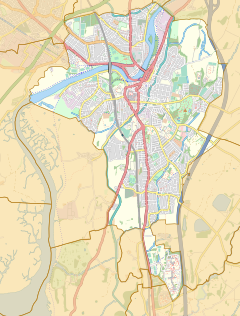
The Glasgow and South Western Railway (G&SWR) was a railway company in Scotland. It served a triangular area of south-west Scotland between Glasgow, Stranraer and Carlisle. It was formed on 28 October 1850 by the merger of two earlier railways, the Glasgow, Paisley, Kilmarnock and Ayr Railway and the Glasgow, Dumfries and Carlisle Railway. Already established in Ayrshire, it consolidated its position there and extended southwards, eventually reaching Stranraer. Its main business was mineral traffic, especially coal, and passengers, but its more southerly territory was very thinly populated and local traffic, passenger and goods, was limited, while operationally parts of its network were difficult.
The Maryport & Carlisle Railway (M&CR) was an English railway company formed in 1836 which built and operated a small but eventually highly profitable railway to connect Maryport and Carlisle in Cumbria, England. There were many small collieries in the area and efficient access to the harbour at Maryport was important.

The Lancaster and Carlisle Railway was a main line railway opened between those cities in 1846. With its Scottish counterpart, the Caledonian Railway, the Company launched the first continuous railway connection between the English railway network and the emerging network in central Scotland. The selection of its route was controversial, and strong arguments were put forward in favour of alternatives, in some cases avoiding the steep gradients, or connecting more population centres. Generating financial support for such a long railway was a challenge, and induced the engineer Joseph Locke to make a last-minute change to the route: in the interests of economy and speed of construction, he eliminated a summit tunnel at the expense of steeper gradients.

The Cumbrian Coast line is a rail route in North West England, running from Carlisle to Barrow-in-Furness via Workington and Whitehaven. The line forms part of Network Rail route NW 4033, which continues via Ulverston and Grange-over-Sands to Carnforth, where it connects with the West Coast Main Line.

Lancaster railway station is a railway station that serves the city of Lancaster in Lancashire, England. It is one of the principal stations on the West Coast Main Line. It is located 20 miles 78 chains (33.76 km) from Preston and is the zero point for mileages onward to Carlisle.
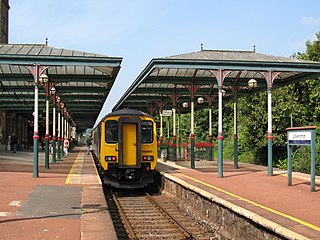
Ulverston is a railway station on the Furness Line, which runs between Barrow-in-Furness and Lancaster. The station, situated 9+1⁄2 miles (15 km) north-east of Barrow-in-Furness, serves the market town of Ulverston in Cumbria. It is owned by Network Rail and managed by Northern Trains.
The Preston and Wyre Railway was promoted to open up agricultural land in the Fylde in Lancashire, access a new port at what became Fleetwood and the Lancaster Canal at Preston: it opened in 1840. An associated company built the dock leading to the company changing its name to the Preston and Wyre Railway, Harbour and Dock Company. Passenger business was more buoyant than expected, and the company built branch lines to the nascent resort of Blackpool and Lytham that opened in 1846. At that time the line was leased by the Lancashire and Yorkshire Railway and later the London and North Western Railway took a share in the lease which was later converted to outright ownership. The Preston and Wyre Railway continued to be jointly owned as the Preston and Wyre Joint Railway.
The Lancaster and Preston Junction Railway opened its twenty-mile line in 1840 in Lancashire, England. The company was not commercially successful. When the Lancaster and Carlisle Railway opened in 1846, the L&PJR became part of a busy trunk railway. It had never had the money to provide substantial track equipment or proper signalling arrangements. Most of the line is in use today as part of the West Coast Main Line railway and has been electrified. None of the L&PJR stations is still in use.
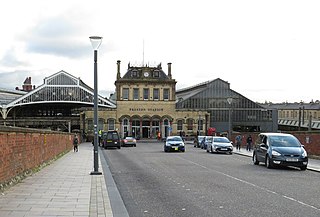
Preston railway station in Preston, Lancashire, England, is a major station on the West Coast Main Line, roughly half-way between London Euston and Glasgow Central. It is served by Avanti West Coast, Northern Trains and TransPennine Express services, plus Caledonian Sleeper overnight services between London and Scotland. It is also served by the Calder Valley line to Leeds and York, and by branch lines to Blackpool, Ormskirk, and Colne.

Lichfield Trent Valley is a railway station on the outskirts of the city of Lichfield in Staffordshire, England. It is one of two stations in Lichfield, the other being Lichfield City in the city-centre. It is a split-level station, with low level platforms served by the Trent Valley section of the West Coast Main Line, and a single high level platform, which is the northern terminus of the Cross-City Line.
The Portpatrick and Wigtownshire Joint Railways was a network of railway lines serving sparsely populated areas of south-west Scotland. The title appeared in 1885 when the previously independent Portpatrick Railway (PPR) and Wigtownshire Railway (WR) companies were amalgamated by Act of Parliament into a new company jointly owned by the Caledonian Railway, Glasgow & South Western Railway, Midland Railway and the London & North Western Railway and managed by a committee called the Portpatrick and Wigtownshire Joint Committee.
The Glasgow, Barrhead and Kilmarnock Joint Railway was a railway jointly owned by the Caledonian Railway and the Glasgow and South Western Railway, completed in 1873, and giving the latter a shorter access to its Carlisle main line. A branch to Beith was also built.
Girvan and Portpatrick Junction Railway (G&PJR) was a railway company in Scotland. It opened in 1877 between Girvan and Challoch Junction, where it joined the Portpatrick Railway, which had already reached Stranraer from Castle Douglas. Portpatrick had been an important ferry terminal for traffic to and from the north of Ireland, but its significance was waning and Stranraer assumed greater importance. The new line formed part of a route between Glasgow, Ayr and Stranraer.

Maudlands railway station was the original Preston terminus of the Preston and Wyre Joint Railway to Fleetwood, in Lancashire, England. It was located on Leighton Street. The line and the station opened on 15 July 1840. The line crossed the Lancaster and Preston Junction Railway (L&PJR) on the level, immediately to the west of the station.

Lancaster Green Ayre railway station was the Midland Railway's station in the city of Lancaster in England. The line between Green Ayre and Morecambe was used for pioneering experimental electrification via overhead wires.

Hest Bank railway station was opened by the Lancaster and Carlisle Railway (L&CR) three miles north of Lancaster Castle railway station. The line had been authorised in 1844 and a station was proposed for the village of Hest Bank, Lancashire, the following year. It opened in 1846 along with the line. The station continued to serve the village of Hest Bank until its closure in 1969. The site remains notable as being the point at which the present-day West Coast Main Line (WCML) comes nearest to the west coast. Views of Morecambe Bay can be glimpsed from trains on this section of the line.
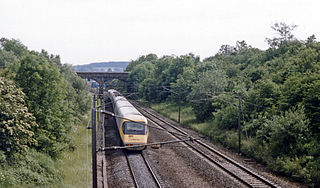
Clifton & Lowther railway station was a station on the Lancaster and Carlisle Railway (L&CR) south of Penrith near to the village of Clifton. Although it was the original terminus to cross Pennines rail traffic on the Eden Valley Railway, it was rapidly by-passed by a new line and junction. The station, which was on the West Coast Main Line, was treated as a private stop by the Earls of Lonsdale.

Lowton railway station served the village named Town of Lowton to the east of Newton-le-Willows and south of Golborne.
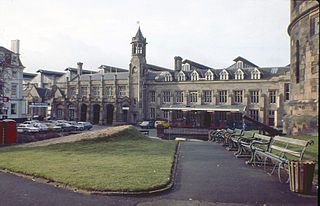
Carlisle, in North West England, formed the focus for a number of railway routes because of the geography of the area. At first each railway company had its own passenger and goods station, but in 1847 passenger terminal facilities were concentrated at Citadel station, which is in use today. Goods facilities remained dispersed, and goods wagons passing through were remarshalled, incurring delay and expense.
Maxwell House railway station served Preston, Lancashire, England, from 1842 to 1844 on the Lancaster and Preston Junction Railway.

